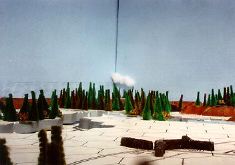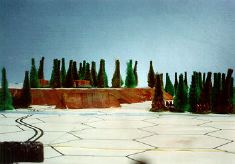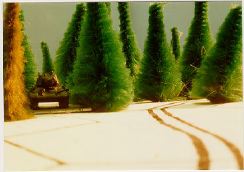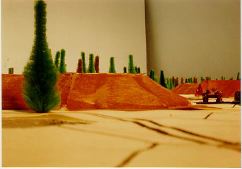PictureBlitz: A Play-By-Photo variant for AH's PanzerBlitz
by Brian McCue. (c)1997 Permission granted to copy for non-commercial use.General
The idea is to play referreed play-by-mail PanzerBlitz using limited observation via unit's-eye-view photographs of a micro-armor-scale version of the game (with miniatures on a 3-D board) as the means of discerning where the other side's units are. This game is made possible by the use of long exposure times and very small apertures, leading to sufficiently large depth-of-field that the whole picture can be in focus even though some parts are only inches away and others are two or three feet away.Purpose (Why go to so much trouble?)
- The observation pictures reveal much less information
than players receive in face-to-face play, but more than
they receive in refereed double-blind games in which
enemy units are revealed only if seen according to the
game's infamously restrictive "Panzerbush" line-of-sight
rules.
- The use of observation introduces a entirely new
aspect of play that would be impossible to create in a
traditional boardgame setting. Some units are more
readily identified than others, some terrain types block
visibility more than others, and so on.
- The game refocuses attention onto the miniatures, which are too often ignored in miniatures games, wherein the majority of player time is spent flipping through charts and rules and less attention is paid to the miniatures than to measuring the distances between them. Visual identification of tanks becomes a key skill, and camouflage becomes especially interesting. It has been complained that "most wargamers can't tell a Panzer III from a Panzer IV." They'll have to learn in this game.
Scale
PanzerBlitz hexes represent 250 meters and are 20 millimeters across, so the scale of the original mapboard is 20mm/250 meters or 1:12,500. On the miniatures board, the hexes are blown up to 43mm and the scale correspondingly enlarged to approximately 1:5800, roughly comparable to the Command Decision scale of 1:4572 that applies if one plays using 50-yard centimeters instead of 50-yard inches. In either case the 1/285 figures, vehicles, and vertical terrain scale are about 20 times too large, a circumstance somewhat ameliorated by the fact that each model vehicle represents a platoon of actual vehicles. The PanzerBlitz stacking limits do not look unreasonable on the board because two or three vehicles really do pretty much fill up a hex.[Editor's Note: Brian is working on a description of both how to build the board and how to take the photograph's. As soon as he is done, I'll include links to those documents.]
Sample Photos
The following are sample pictures from an ongoing game of PictureBlitz. Note the road (parallel lines), the hex borders, and the terrain features -- and of course the TANKS!| This photo shows a number of things: The hex
pattern is clearly visible, as is the road
(double-line) running through a town (lower right)There
is also a gully (running horizontally across the
picture), with hills in the background. Tanks are
visible in the trees just below and to the right of the
"cloud", and just above the gully. From the elevation
of the picture, we must be on a hill.
Note also the basic contruction (layered styrofoam insulation) and the vertical pieces (also of insulation styrofoam) simulating the sky. Click here to see a larger view of the same picture. (75k) |
 |
| This photo is interesting mainly because of the
infantry hiding in the tree (middle right).
Click here to see a larger view of the same picture. (75k) |
 |
| This is definitely NOT what you want to see!
Click here to see a larger view of the same picture. (78k) |
 |
| This is a good ground level photo, and illustrates
exactly how effective hills are to hide behind.
Click here to see a larger view of the same picture. (72k) |
 |
Game Sequence
This play-by-mail game uses simultaneous movement. Players submit orders at the beginning of the turn specifying fire, movement, and observation attempts. The referee carries out the orders according to the very-revised sequence of events in the turn:- Close assault. Close assaults are usually
unambiguous: orders are not given for close assaults,
though in the rare cases of ambiguity the referee will
have to check with a player). Close assaults all happen
"simultaneously" (effects do not take effect yet). Units
that fired last turn are not eligible to make close
assaults.
- Fire execution, including mines (effects do
not take effect yet).
- Undispersal of units dispersed last turn.
- Close assault, mines, and fire take effect
in that order, with DD results handled according to the
original rules. Note that mutual annihilation is possible
in this game.
- Movement. Units that fired this turn are not
eligible to move.
- Observation. Company command units (see below) make observations in specified directions.
Rules
- The referee's decisions, including the way he
presents the game on the miniatures board and thence into
the photographs, are final. Players specify only normal
game functions (fire and movement) and observation; they
do not specify how their units are to be placed within
the hexes for purposes of photography. The regular rules
of PanzerBlitz apply unless modified here.
- Fire: For purposes of fire, line-of-sight is
determined on the regular board using the regular rules,
plus the Real Line of Sight optional rule. Players will
definitely need to maintain their own views of the game
in terms of setups on the regular board. What players can
see in the Observation pictures has nothing to do with
what they can shoot at.
- Command and Control: Forces are divided into
companies by the referee when he specifies the scenario.
Each company has a unit that is the command unit. If the
command unit is destroyed, command devolves (except for
exceptions noted by the referee before the game) to the
next higher-ID'd unit in the company. (Most companies are
homogeneous.) An order can be given to a unit if the unit
is within 6 hexes of its company commander.
- Observation: Each picture is taken from a
company commander's point of view. For each company
commander, the player gets one picture. He specifies in
his orders the direction in which the observation is to
be made. A company commander can always observe
regardless of other activities he may perform such as
moving or firing, but cannot observe if dispersed.
Pictures cover approximately 60 degrees and can be aimed
at a hex side or a hex vertex. Observation is done in one
of twelve directions: directions are specified as North
(a hex side), North North East (a vertex), North East
(side), East (vertex), South East (side), South South
East (vertex), South (side), South South West (vertex),
South West (side), West (vertex), North West (side), and
North North West (vertex).
- Photo Interpretation (see also rules 0 and
1): Pictures show the referee's vision of what the
PanzerBlitz unit would "really" see, e.g.
infantry can hide in buildings but vehicles can't. Unit
facings are indicative of the direction in which the
units are moving or shooting. Contents of trucks, wagons,
and halftracks are not visible, towed weapons transported
by these vehicles are. Wrecks are portrayed with cotton
"smoke" billowing from the vehicle. Dispersal is not
visible.
-
Movement: Movement is simultaneous, governed
by an impulse movement system: read down the correct
column of the chart to find the impulses in which units
moving at a given speed (in movement points/turn, not
hexes/turn) expend movement points. Stacking limits
apply at all times and a unit will not move into an
overstack. If the overstack no longer exists when a
later movement impulse would have the unit move, the
unit resumes movement. Note that, as in real life,
pile-ups can occur if, for example, an unexpected block
is encountered on a road. Note that in many cases units
require more than one movement point to enter a hex; in
these cases conflicts will be resolved in favor of the
unit that first completes entry. If a tie exists on
this basis, it will be resolved in favor of the unit of
greater movement capability (the number printed on the
counter); ties on this basis the referee will resolve
with a die roll.
MOVEMENT 1 2 3 4 5 6 7 8 9 10 11 12 I
M
P
U
L
S
E1 . . . . . 1 1 1 1 1 1 1 2 . . . 1 1 . 2 . 2 2 2 2 3 . . 1 . . 2 . 2 . 3 3 3 4 . 1 . . 2 . 3 3 3 . 4 4 5 . . . 2 . 3 . . 4 4 5 5 6 1 . . . 3 . 4 4 5 5 . 6 7 . . 2 . . 4 . 5 . 6 6 7 8 . 2 . 3 4 . 5 . 6 . 7 8 9 . . . . . 5 . 6 7 7 8 9 10 . . . . 5 . 6 7 8 8 9 10 11 . . 3 4 . 6 . . . 9 10 11 12 . . . . . . 7 8 9 10 11 12 - Autonomous Action by Units: Units will sometimes act autonomously, taking actions so obvious that the referee thinks the unit would do them even without orders. The main example is close assault. The referee is to view this capability as useful in helping players, not in frustrating them.
Optional Rules
- Pathetic Russian Command and Control: Unlike
the German player, the Russian player does not get an
accounting of any of his units that were unable to
complete their movement orders. This simulates the cruder
command and control of the Soviets. An order can only be
given to a Russian unit if it is within 6 hexes of its
company commander and its company commander has a line of
sight to it. (N.B.: this is less restrictive than a
requirement that the unit itself be "visible" to the
commander, and is also definitely not a requirement that
the commander actually use this line of sight to observe
the unit via a picture.) If a unit is given impossible
orders or orders that presuppose a starting hex different
from the unit's actual hex, the unit will not move.
- Pathetic Russian Intelligence: Unlike the German player, the Russian player is told only the type of fire, not the odds at which it is received. Even this information is provided only if the target unit survives.


